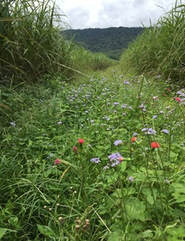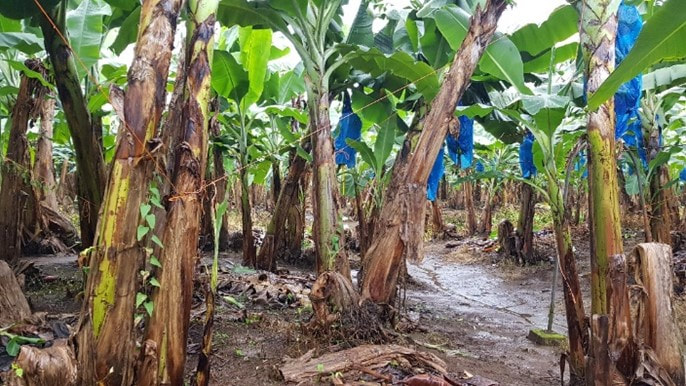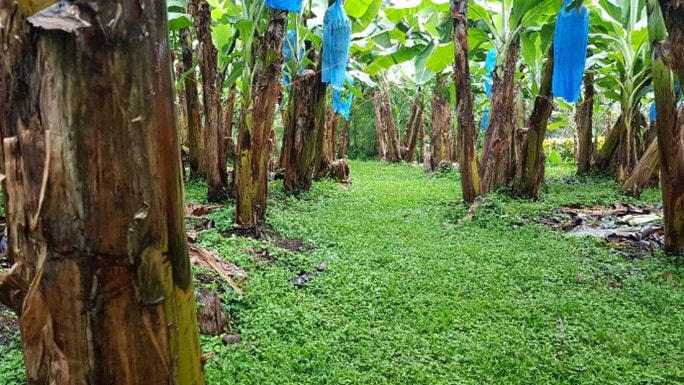|
written by: Leo Kerner & Angela Saenz Imagine a lush, highly diverse field of papaya that requires limited chemical interference to control insect and weed pests. This is the reality of living mulch. Dr. Robin Gomez, an associate professor of Weed Science at the University of Costa Rica, studies sustainable pest control methods in tropical ecosystems. He suggests that the key to successful implementation of sustainable agricultural practices relies on acquiring specialized knowledge of each system. Costa Rica harbors a variety of microclimates due to its varied geography, topography, and dry and wet seasons. In the Caribbean, high humidity, frequent rainfall, and sedimentary soils with high clay-content make these areas prone to flooding and erosion. This necessitates practices that protect crops, such as deep drainage, raised beds, and integrated living mulches. However, agriculture is innately connected to human intervention, and yields in each cropping system and field benefit when the humans who care for it have an intimate understanding of the land’s geography and ecology. By integrating agriculture into natural ecosystems, agricultural production suffers less from pest invasions and benefits from the ecological resilience promoted by vegetative diversification. Living mulches help provide vital ecosystem services, such as insect pest and weed control, prevention of soil and nutrient erosion, enhancement of soil health, and additions to the soil's nutrient composition, to vegetatively homogenous croplands. A living mulch does the job of naturally occurring ground cover, which provides these services outside of an agroecosystem, and grows alongside the main cash crop. Many different types of living mulches are used in tropical ecosystems, both native and introduced, with benefits and contributions to ecosystem services being as abundant. In his presentation, Dr. Gomez shared examples of many agricultural products commonly grown in Costa Rica that benefit from living mulches. We will focus on three examples: Papaya, banana, and sugar cane. Ongoing research Papaya In Costa Rica, papaya is grown by 700 farmers largely in the lowlands of the coasts, covering a total of 950 ha in the country. Papaya production is highly dependent on chemical pest protection, which can significantly impact the surrounding ecosystem and is dwindling in effectiveness. To manage insect pests, such as papaya mealybugs (Paracoccus marginatus), whiteflies (Trialeurodes variabilis), papaya fruit fly (Toxotrypana curvicauda), leafhoppers (Empoasca spp.) and plant lice (Phsyllidae), it’s often necessary to spray twice per week. To reduce chemical inputs into the environment, Dr. Gomez modified the agroecosystem and created habitats that promote insect predators and suppress weeds. With a mix of kudzu, sun hemp, crotalaria and mung bean as perennial living mulch, Dr. Gomez’s lab saw a reduction of up to 95% in deleterious weeds and grasses that harbor plant lice, which are vectors of papaya pathogens. Plant lice populations found on crops significantly decreased thanks to this practice, and a higher abundance of insect predators was promoted. Banana Bananas in Costa Rica are a massive product sold on the international market, making up 8.8% of all foreign exports and 76% of the jobs in Limón, a Caribbean province. However, banana production faces many challenges, including soil erosion, nutrient leaching, biodiversity loss, soil compaction, and environmental pollution. Dr. Gomez collaborated on a research project that tested whether use of a living mulch would help alleviate some of these problems. Soil compaction, erosion, plant cover and biomass, and soil microbial respiration were tested in banana plots with grasses and other plants as living mulch as compared to those without (Figure 1). They found that bare ground plots were losing up to 4 tons of soil a year, whereas those with living mulch lost around 0.5 tons of soil a year. Moreover, plots with living mulch cover had a healthier soil biotic community with greater diversity and abundance of soil microorganisms. Soil compaction and respiration were also improved in plots that utilized living mulch, showing that soil health in banana production can greatly benefit from living mulch practices (for more details see Valverde Araya 2021). In addition to cover crops and living mulches, native plants can also provide different ecosystem services to the agroecosystem. These plants are well adapted to the climatic conditions of the area, which makes them easy to establish. By controlling noxious weeds and selecting native beneficial plants, Dr. Gomez explained that producers not only maintain these native plants near the crops which can sometimes establish as living mulches. Sugar cane Farmers and extension agents of sugarcane plantations noted a higher incidence of insect pests, such as the sugarcane borer (Diatraea saccharalis) and leafhopper (Perkinsiella saccharicida), in plantations with more stringent weed control compared to areas where weeds grew in the margins. Research studying this phenomenon found a positive relationship between native weeds present on field margins and beneficial insects, including predatory plant bugs (Miridae), predatory long-legged flies (Dolichopodidae), and parasitoid wasps (Chalcididae). These natural enemies are useful for the biological control of sugarcane pests. Results from this research are now used to help growers understand the importance of keeping native vegetation for pest suppression (Figure 2) as a low-cost alternative to chemical pesticides and weed control.  Figure 2. Native weeds in sugarcane plantations function as reservoirs for natural enemies of sugarcane pests. Photo courtesy of A. Saenz. Figure 2. Native weeds in sugarcane plantations function as reservoirs for natural enemies of sugarcane pests. Photo courtesy of A. Saenz. At the end of his talk, Dr. Gomez highlighted the importance of using living mulches and native vegetation as tailor-made strategies for each agroecosystem. He also emphasized that finding agricultural practices that reduce grower costs is vital to their adoption. Some farmers may have had limited access to education. For example, scholarship of many papaya farmers in Costa Rica doesn’t go beyond middle school. This creates a strong need for the development of effective science communication strategies between researchers and landowners. Dr. Gomez stated that considering local knowledge and gaining perspective on the different ecosystem services that plants and insects provide is crucial for the adoption of these practices by local farmers, as well as the continued development of sustainable agricultural practices. Local farmers know their land intimately and can distinguish between the most effective and sustainable methods for weed and pest suppression, so by equipping these farmers with the tools and knowledge to use a living mulch instead of high input chemicals, they can improve their agricultural practices and have higher yields while taking advantage of the ecosystem services that these practices can provide. Authors: Leo Kerner is a MS student in the Hooks lab researching the impact of living mulch on weed and insect pest suppression in specialty vegetable crops. He is also interested in looking at how vegetative diversification plays a role in arthropod predator-prey community dynamics. Angela Saenz is a PhD student in the Gruner lab, and her research focuses on the synchrony and phenology of the Emerald Ash Borer and its introduced natural enemies in forested areas. Comments are closed.
|
Categories
All
Archives
June 2024
|
Department of Entomology
University of Maryland
4112 Plant Sciences Building
College Park, MD 20742-4454
USA
Telephone: 301.405.3911
Fax: 301.314.9290
University of Maryland
4112 Plant Sciences Building
College Park, MD 20742-4454
USA
Telephone: 301.405.3911
Fax: 301.314.9290



 RSS Feed
RSS Feed




